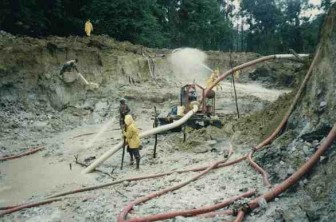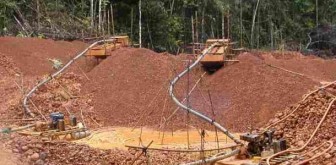The Guyana Geology and Mines Commission (GGMC) has sent the first definitive official signal that gold production could be heading for another record year in 2012, announcing that first quarter declaration had reached 88,873 ounces, exceeding the first quarter of 2011 by 10,864 ounces or 14 %.
The GGMC has already confidently declared that local gold production could be heading for “another record”, a view endorsed by the Guyana Gold Board, with an industry source telling Stabroek Business, “the early increase in returns could have been predicted since late last year given the additional millions of dollars that miners were investing in recruitment and labour.”

According to the GGMC, during the first quarter of this year the value of gold production reached $27.1 billion, a 31.4 per cent increase over 2011, a circumstance which the commission said was due to both increased production and increased prices. At the start of the first quarter, 2012, gold price stood at US$1,598 an ounce, closing the quarter at US$1,662 per ounce, a cumulative increase of 22.5% relative to the first quarter of 2011.
The disclosure by the GGMC that 2012 gold production could be pushing towards 400,000 ounces, or even higher, comes in the wake of the heightened attention that the industry has attracted since earlier this year.
Government, in what it said was a further move to ensure that the sector functioned within the confines of the country’s environmental laws, established a Ministry of Mining and Natural Resources, a move that has not sat well with the sector as a whole. One of the more significant developments in the sector since the advent of the new ministry has been the expulsion from the country of foreign (Brazilian) miners operating without work permits and the creation of new procedures for the acquisition of those permits.

The operation of foreign miners here has long been believed to be underpinned by corrupt practices including reported frequent shakedowns by members of the Guyana Police Force inspecting work permits. Miners have told this newspaper that the new procedures for the acquisition of work permits are unlikely “to end the corruption” going on in the industry.
Industry watchers have also expressed the view that the advent of the new ministry may represent an attempt by government to take more direct control of an industry that has become a key earner for the country’s economy, reducing the authority of the GGMC. While the commission has been strengthened recently by two senior appointments at the level of Deputy Commissioner, the organization has come under fire for its failure to effectively enforce mining laws, a pursuit which is also believed to be underpinned by corrupt practices.
Since the creation of the new ministry, government has moved to initiate a series of amendments to the mining regulations which point unerringly in the direction of greater official control of the industry. The most recent amendments require small and medium-scale mining operations to retain stringent on-site production records and to give notice of the removal of a dredge from one location to another. Other new regulations also require that the minister’s permission be sought to divert or alter creeks and other waterways in mining areas and require claim or permit holders enter into written agreements for sub-letting.
Not unexpectedly, gold was the main contributor to mineral production value in the first quarter of this year, claiming 74 per cent of the overall value of minerals for the period. Bauxite production accounted for 23 per cent of the overall value, stone for 2 per cent, diamonds, for 1 per cent and sand for less than one per cent.




